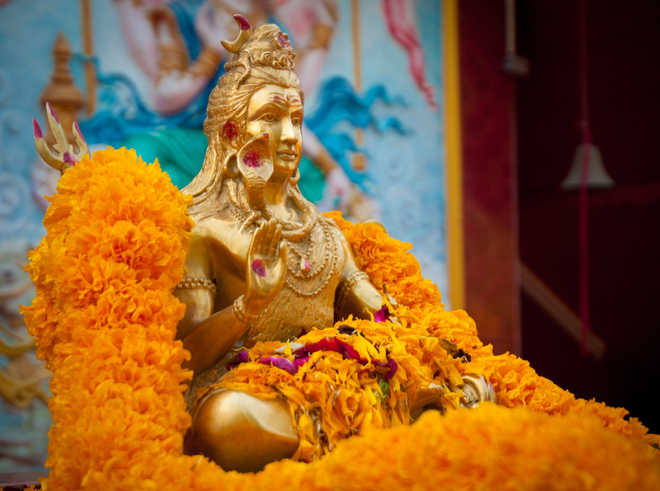Dr Satish K Kapoor
‘A running river
Is all legs.
A burning fire
Is mouths all over.
A blowing breeze
Is all hands.
So,
Lord of the caves,
For your men,
Every limb is symbol.’
- Allama Prabhu, Virashaiva saint (12th century)
Shiva is one of the three aspects of divinity, the other two being Brahma and Vishnu. He is beyond the three states of consciousness – jagrat, waking, svapna, dreaming and sushupti, deep sleep, as he remains in the fourth dimension called turiya. In the Shiva Sahasranama, the Lord is described as vyaktavyaktah, the manifest and the unmanifest, characharatma, the self of the moving and the non-moving, and antarahitatma, the concealed self. His head is likened to the sage Atharvan, his face to Samaveda, his boundless eyes to the hymns of Rigveda, and his feet and arms to the prose mantras of Yajurveda. His clothes are the four directions.
Although Shiva is usually depicted with one head, he is Pancha vaktra - the Lord with five faces or aspects, namely, Ishana, Tatpurusha, Aghora, Vamadeva and Sadyojata. These forms symbolise the scheme of creation rooted in twenty-four constituents – five gross and five subtle elements, five organs of action, and five of knowledge, besides mind, ego, intellect, and the individual soul. The Ishana form presides over the human soul, Tatpurusha over the objects of enjoyment, Aghora over the principle of intelligence, Vamadeva over the ego, and Sadyojata over creation.
In popular representations, Shiva is shown with human attributes, each having a special meaning. He stays at the top of Mount Kailasha, under a tree, or in a cremation ground, because he loves to meditate in solitude. He reclines on the holy ash and smears his body with it, because ash is the ultimate reality of life.
Shiva uses the skin of tiger or deer as his seat and dress, indicating his power and control of lower instincts. His blue neck signifies compassion for the world. During churning of the ocean of milk by gods, he consumed the deadly poison halahala, holding it in his neck which turned blue, thus earning him the epithet of Nilakantha. He became known as Gangadhar when he protected the earth by making the river Ganga flow from his matted hair.
Shiva is called Chandrashekhara because he wears the moon as his crown. The moon is symbolic of time which he regulates, and of mind, which he controls. His forehead is marked by three horizontal golden stripes, indicating that he is three gods in one. He is called Trayambaka, being endowed with the third eye, characteristic of inner vision, wisdom and power, that burns up ignorance and passion, when opened. His adornments are a string of skulls, serpent Vasuki, and Rudraksha, seeds of Elaeocarpus. These show respectively, that he is sarvabhutaharah, the destroyer of the created beings, atandritaya, ever active, and mahatapah, a great ascetic.
Shiva is seen with his consort, Parvati, the epitome of pure consciousness; his sons, Ganesha and Kartikeya, symbols of intelligence and grace, and ganas, a host of spooks, spirits, and inanimate beings, who obey his command. His mount, the white bull Nandi, signifies dharma, righteousness, of which he is the embodiment.
Shiva’s weapons like pinaka, the staff, ajagava, the bow, pasha, the noose, and trishula, the trident, make him Arindam the vanquisher of foes. Trishula, his favourite weapon, stands for vairagya, dispassion, jnana, supreme knowledge, and samadhi, meditation, or, for iccha, desire, kriya, action and bhakti, devotion.
As Nataraja, the king of dancers, Shiva has four arms spread in all the four directions, which set the rhythm for creation, dissolution and recreation of the universe. During Ananda Tandava, the dance of bliss, Shiva controls the primal elements – the air in his flowing hair, the fire in his left hand, the earth under his right foot, the water in his matted locks, and the rhythmic movements in space. Panini’s aphorisms on Sanskrit grammar originated from the sounds that emanated from his damaru, a small drum, which he plays with his upper right hand.
In his Dakshinamurti form, Shiva teaches scriptures, yoga and music, with his eyes closed. As the Lord Ardhanarishwar, he displays both male and female characteristics. He is called vihita raginam, the lord devoid of all passions. His emblem, the Shivalinga, is not a phallic symbol, but a representation of the formless reality.
Shiva is Ashutoshi, one who is pleased quickly, and Navanita hridaya, one whose heart melts as butter. He is called Bhole Natha, Bhole Baba or Bhole Bhandari, as he personifies innocence, and is bounteous when beckoned by devotees. Namah shivaya is the bija mantra, seed syllable, to invoke his presence. It occurs in Rudra suktam of the Yajurveda, and is repeated for material and spiritual purposes. The one who worships Shiva with unflinching faith and devotion becomes Shiva himself, and comes to say, Shivo’ham. Shivo’ham – Shiva am I. Shiva am I.
(Dr Satish K Kapoor, former British Council Scholar, Principal, Lyallpur Khalsa College, and Registrar, DAV University, is a noted author, historian and spiritualist based in Jalandhar city).
Unlock Exclusive Insights with The Tribune Premium
Take your experience further with Premium access.
Thought-provoking Opinions, Expert Analysis, In-depth Insights and other Member Only Benefits
Already a Member? Sign In Now











